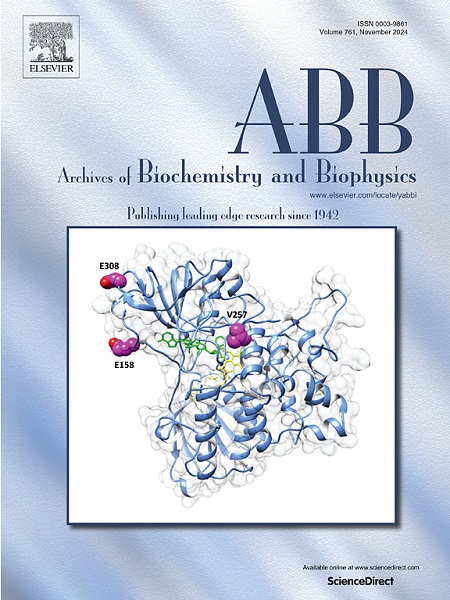附件蛋白 A2 野生型与 E53A、E96A、D162A、E247A 和 D322A 突变体的不同结构特征、理化性质和钙结合能力。
IF 3.8
3区 生物学
Q2 BIOCHEMISTRY & MOLECULAR BIOLOGY
引用次数: 0
摘要
膜联蛋白A2 (ANXA2)是一种Ca2+依赖的多功能蛋白,含有5个Ca2+结合域,但它们的功能意义和差异尚不清楚。在本研究中,犬ANXA2的5个Ca2+结合域(分别与人类和其他哺乳动物的ANXA2相同98.82%和96.76-99.41%)中的谷氨酸(E)或天冬氨酸(D)通过位点定向诱变被丙氨酸(A)取代。构建了重组ANXA2野生型(WT)和E53A、E96A、D162A、E247A和D322A突变体,并利用细菌表达系统进行了表达,随后用镍-硝基三乙酸(Ni-NTA)基质进行了高亲和纯化。通过SDS-PAGE和Western blotting证实了其表达和纯化的有效性。采用nanolc - esi - q- tof串联质谱法对其氨基酸序列进行了验证。ATR-FTIR光谱分析显示,它们的二级结构差异显著(α-螺旋减少,随机螺旋增加)。理化性质分析表明,与WT相比,所有突变体的分子量略有下降,而等电点、脂肪族指数、亲水性、静电电位和分子疏水性的总平均值略有上升。有趣的是,这些突变体(特别是E96A和D322A)的Ca2+结合能力明显低于WT。和Ca2+的结合能力,E53A, E96A, D162A, E247A和D322A突变体的ANXA2与其WT有显著差异,这与负电荷E/D的损失一致。其中E96A和D322A的Ca2+结合能力最低。这些数据和重组蛋白将有助于进一步研究ANXA2中单个Ca2+结合域的Ca2+依赖功能。本文章由计算机程序翻译,如有差异,请以英文原文为准。

Differential structural characteristics, physicochemical properties, and calcium-binding capabilities of annexin A2 wild-type versus E53A, E96A, D162A, E247A and D322A mutants
Annexin A2 (ANXA2) is a Ca2+-dependent multifunctional protein containing five Ca2+-binding domains, but their functional significance and difference remain unclear. Herein, glutamic acid (E) or aspartic acid (D) in five Ca2+-binding domains of canine ANXA2 (98.82 % and 96.76–99.41 % identical to ANXA2 from human and other mammals, respectively) was substituted by alanine (A) using site-directed mutagenesis. Recombinant ANXA2 wild-type (WT) and E53A, E96A, D162A, E247A and D322A mutants were constructed and expressed using a bacterial expression system followed by high-affinity purification using nickel-nitrilotriacetic acid (Ni-NTA) matrix. Efficacies of their expression and purification were confirmed by SDS-PAGE and Western blotting. Their amino acid sequences were verified by nanoLC-ESI-Qq-TOF tandem mass spectrometry. ATR-FTIR spectroscopy revealed that their secondary structure significantly differed (α-helix decreased but random coil increased in all mutants). Analyses of physicochemical properties revealed that molecular weight slightly decreased, whereas isoelectric point, aliphatic index, grand average of hydropathicity, electrostatic potential and molecular hydrophobicity potential slightly increased in all the mutants compared with WT. Interestingly, Ca2+-binding capability of these mutants (particularly E96A and D322A) significantly decreased from that of WT. In summary, secondary structure, physicochemical properties, and Ca2+-binding capability of E53A, E96A, D162A, E247A and D322A mutants of ANXA2 significantly differed from its WT, consistent with the loss of negatively charged E/D. In particular, E96A and D322A exhibited the lowest Ca2+-binding capability. These data and recombinant proteins would be useful for further investigations of the Ca2+-dependent functions of individual Ca2+-binding domains in ANXA2.
求助全文
通过发布文献求助,成功后即可免费获取论文全文。
去求助
来源期刊

Archives of biochemistry and biophysics
生物-生化与分子生物学
CiteScore
7.40
自引率
0.00%
发文量
245
审稿时长
26 days
期刊介绍:
Archives of Biochemistry and Biophysics publishes quality original articles and reviews in the developing areas of biochemistry and biophysics.
Research Areas Include:
• Enzyme and protein structure, function, regulation. Folding, turnover, and post-translational processing
• Biological oxidations, free radical reactions, redox signaling, oxygenases, P450 reactions
• Signal transduction, receptors, membrane transport, intracellular signals. Cellular and integrated metabolism.
 求助内容:
求助内容: 应助结果提醒方式:
应助结果提醒方式:


